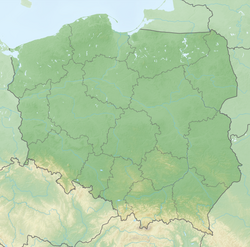Battle at Tillendorf
| date | November 9, 1704 |
|---|---|
| place | Tillendorf near Fraustadt , today's Poland |
| output | Victory of the Swedes |
| Parties to the conflict | |
|---|---|
| Commander | |
| Troop strength | |
| more than 1500 men | 1500 men |
| losses | |
|
around 1500 dead |
|
1st phase: Swedish dominance (1700–1709)
Riga I • Jungfernhof • Varja • Pühhajoggi • Narva • Pechora • Düna • Rauge • Erastfer • Hummelshof • Embach • Tartu • Narva II • Wesenberg I • Wesenberg II
Arkhangelsk • Lake Ladoga • Nöteborg • Nyenschanz • Neva • Systerbäck • Petersburg • Vyborg I • Porvoo • Neva II • Koporje II • Kolkanpää
Vilnius • Salads • Jacobstadt • Walled Courtyard • Mitau • Grodno I • Olkieniki • Nyaswisch • Klezk • Ljachavichy
Klissow • Pułtusk • Thorn • Lemberg • Warsaw • Posen • Punitz • Tillendorf • Rakowitz • Praga • Fraustadt • Kalisch
Grodno II • Golovchin • Moljatitschi • Rajowka • Lesnaja • Desna • Baturyn • Koniecpol • Weprik • Opischnja • Krasnokutsk • Sokolki • Poltava I • Poltava II
2nd phase: Sweden on the defensive (1710–1721)
Riga II • Vyborg II • Pernau • Kexholm • Reval • Hogland • Pälkäne • Storkyro • Nyslott • Hanko
Helsingborg • Køge Bay • Gulf of Bothnia • Frederikshald I • Dynekilen Fjord • Gothenburg I • Strömstad • Trondheim • Frederikshald II • Marstrand • Ösel • Gothenburg II • Södra Stäket • Grönham • Sundsvall
Elbing • Wismar I • Lübow • Stralsund I • Greifswalder Bodden I • Stade • Rügen • Gadebusch • Altona • Tönning II • Stettin • Fehmarn • Wismar II • Stralsund II • Jasmund • Peenemünde • Greifswalder Bodden II • Stresow
The battle near Tillendorf on November 9, 1704 was a military conflict in the Great Northern War . A Russian corps under Colonel Görtz was completely wiped out at Tillendorf near Fraustadt , near Silesia, by a Swedish detachment under the command of General Otto Vellingk .
prehistory
The war of dethroning of Charles XII. against August the Strong was entering its fourth year without a final military decision so far. The Saxons received increasing support from Russian contingents.
The army of Charles XII. had marched in the direction of Lemberg in 1704 to take the city and force the Saxons to an open field battle. Poznan and the capital Warsaw remained without significant protection. A Saxon-Russian army took advantage of this situation. After the Saxons had successfully invaded Warsaw and August the Strong had re-established his claim to the throne, they turned back towards Posen to besiege this fortified city .
The news of the approach of the Swedish king from Lemberg and the withdrawal of August the Strong from Warsaw unsettled the besiegers. The orderly retreat began on October 2nd. This took place in the night and the Swedes marched triumphantly out of the city in the morning to pursue the Saxons. The Saxon army fled home. On the way to Saxony they allied themselves with the von Schulenberg army. The Russian corps also withdrew.
course
The Swedish army under Karl XII had previously provided the Saxon contingent under Johann Matthias von der Schulenburg in the battle of Punitz but could not prevent them from being able to save themselves to safe imperial territory to which the Swedes could not easily access. Colonel Görtz, who commanded the four Russian regiments, had marched up the Obra to join forces under Johann Reinhold von Patkul . The Saxon and Russian infantry split up in order to advance faster. Therefore, the Russian regiments did not take part in the Battle of Punitz.
The Swedish corps of Charles XII. stayed four miles from the Oder near the village of Krangelwitz after the battle of Punitz . When the news came that there was a 1,500-strong Russian detachment near Tillendorf, it was attacked by the Swedes. The Swedish division under Velingk consisted of four cavalry regiments and one dragoon regiment.
The Russians had 14 cannons and built a wagon castle for their defense . The wagon castle was stormed by the Swedes. The Russians then fled to the village. Several hundred of the Russians gathered there and fired at the Swedes from the windows. The Russians did not want to surrender and fought almost to the last man. Many of the Russians burned in their houses. Only six Russians survived the battle. In addition to the 14 cannons, 4 barrels of money fell into the hands of the Swedes.
consequences
After the news of the battle came in from Vellingk, the royal corps set off for it. On November 11th, Charles XII inspected the battlefield near Tillendorf, where the Russians were still unburied.
Afterwards Patkul wanted to force the commanding Colonel Görtz to be brought before a mixed Saxon-Russian court martial because he held him responsible for the loss of the treasure. However, Görtz evaded access and went over to the Swedes.
In mid-December the Swedes took up their winter quarters along the Silesian border from which they could observe possible troop movements of the Saxons.
literature
- Adam Heinrich Dietrich von Bülow: Military biographies of famous heroes of recent times, second volume, Berlin 1804, pp. 58–60
- Sigmund Schott: Max Emanuel, Prince of Würtemberg and his friend Karl XII King of Sweden, Stuttgart, 1839, p. 109f
- Benjamin von Bergmann: Johann Reinhold von Patkul before the judge's chair for posterity, Leipzig, 1806, p. 192ff.
